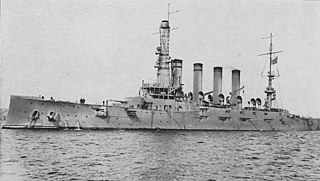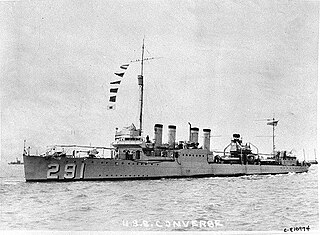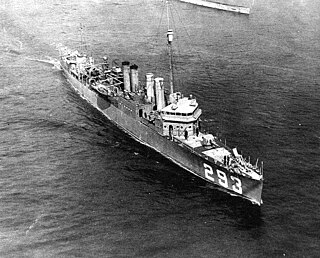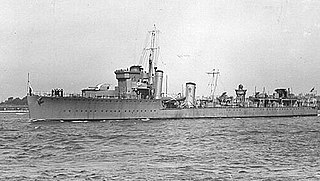
The second USS Maryland (ACR-8/CA-8), also referred to as "Armored Cruiser No. 8", and later renamed Frederick, was a United States Navy Pennsylvania-class armored cruiser.

USS Leary (DD-158) was a Wickes-class destroyer in the United States Navy during World War II. She was named for Lieutenant Clarence F. Leary, posthumously awarded the Navy Cross in World War I.

USS Harding (DD-91) was a Wickes-class destroyer in the United States Navy during World War I. She was the first ship named in honor of Seth Harding.

USS Breese (DD-122) was a Wickes-class destroyer in the United States Navy during World War I, and later redesignated, DM-18 in World War II. She was the only ship named for Captain Kidder Breese.

USS McCall (DD-28) was a Paulding-class destroyer in the United States Navy during World War I and later in the United States Coast Guard, designated CG-14. She was the first ship named for Edward McCall.

USS Satterlee (DD-190) was a Clemson-class destroyer in the United States Navy, entering service in 1919. After brief service until 1922, the ship was placed in reserve. The ship was reactivated for World War II before being transferred to the Royal Navy in 1940. Renamed HMS Belmont, the destroyer was used as a convoy escort in the Battle of the Atlantic where she was torpedoed and sunk on 31 January 1942.

USS McCawley (DD-276) was a Clemson-class destroyer built for the United States Navy during World War I. She was armed with 4 × 4 inch and 2 × 1 pounder guns. She was commissioned on 22 September 1919, served with the Pacific Fleet for 3 years and was laid up on 7 June 1922. McCawley was recommissioned on 27 September 1923, again serving in the Pacific, and decommissioned in 1930 before being sold for scrap.

USS Case (DD-285) was a Clemson-class destroyer in service with the United States Navy from 1919 to 1930. She was scrapped in 1931.

USS Converse (DD-291) was a Clemson-class destroyer built for the United States Navy during World War I.

USS Billingsley (DD-293) was a Clemson-class destroyer built for the United States Navy during World War I.

USS Farquhar (DD-304) was a Clemson-class destroyer built for the United States Navy during World War I.

USS Kennedy (DD-306) was a Clemson-class destroyer built for the United States Navy during World War I.

HMS Castor was one of the Cambrian subclass of the C class of light cruisers. She saw service during the First World War and the Russian Civil War.

HMS Calliope was a C-class light cruiser of the Royal Navy under construction at the outbreak of the First World War. Both Calliope and her sister ship Champion were based on the earlier cruiser Caroline. They were effectively test ships for the use of geared turbines which resulted in the one less funnel. They also received slightly thicker armour. They led into the first of the Cambrian subclass.

USS Kidder (DD-319) was a Clemson-class destroyer in service with the United States Navy from 1921 to 1930. She was scrapped in 1931.

HMS Woolston was a W-class destroyer of the Royal Navy. She served through two world wars, surviving both of them.

HMS Wren (D88/I88) was an Admiralty modified W class destroyer built for the Royal Navy. She was ordered in April 1918 from Yarrow Shipbuilders Limited under the 13th Order for Destroyers of the Emergency War Program of 1918–19. She was the third Royal Navy ship to carry the name, which was introduced in 1653.

HMS Whitley (L23), ex-Whitby, was a W-class destroyer of the British Royal Navy that saw service in the British campaign in the Baltic Sea against Bolshevik forces during the Russian Civil War and in the early months of World War II.

The fifth HMS Valorous, ex-HMS Montrose, was a V-class flotilla leader of the British Royal Navy that saw service in World War I, the Russian Civil War, and World War II.

The first HMS Walrus (D24) was a W-class destroyer of the British Royal Navy that saw service in the final months of World War I.




















